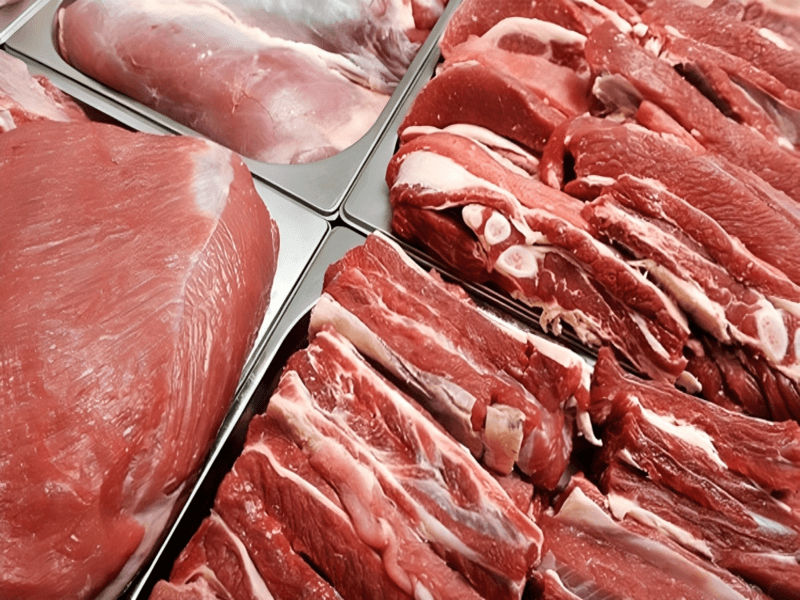
Eid Ul Azha, also known as the Festival of Sacrifice, is one of the most significant Islamic holidays. It commemorates the willingness of Prophet Ibrahim (Abraham) to sacrifice his son as an act of obedience to God.
To honor this event, Muslims around the world perform the ritual sacrifice of livestock, with cow meat being a common choice. While cow meat is a staple in many diets, understanding its benefits and potential side effects is crucial, especially during a period of increased consumption.
Nutritional Benefits of Cow Meat
- High-Quality Protein Source
- Cow meat is an excellent source of high-quality protein, which is essential for building and repairing tissues. Proteins are made up of amino acids, some of which the body cannot produce on its own. Cow meat provides all the essential amino acids, making it a complete protein source.
- Rich in Essential Vitamins and Minerals
- Iron: Cow meat, particularly red meat, is a rich source of heme iron, which is more readily absorbed by the body compared to non-heme iron found in plant sources. Iron is crucial for the formation of hemoglobin and myoglobin, proteins that carry oxygen in the blood and muscles, respectively.
- Vitamin B12: Essential for nerve function and the production of DNA and red blood cells, cow meat is one of the best natural sources of vitamin B12.
- Zinc: Important for immune function, DNA synthesis, and wound healing, cow meat provides a significant amount of dietary zinc.
- Other B Vitamins: Cow meat is also a good source of niacin, riboflavin, and vitamin B6, which are important for energy production and maintaining healthy metabolism.
- Supports Muscle Growth and Maintenance
- The protein content in cow meat helps support muscle growth and maintenance, making it an excellent dietary choice for individuals looking to build or preserve muscle mass, especially in conjunction with regular exercise.
- Satiating and Nutrient-Dense
- Due to its high protein and fat content, cow meat is highly satiating, which can help regulate appetite and reduce overall calorie intake. This can be particularly beneficial for weight management.
Potential Side Effects of Cow Meat Consumption
- Cardiovascular Health Concerns
- Saturated Fat and Cholesterol: Cow meat, especially certain cuts, can be high in saturated fat and cholesterol. Excessive intake of these can contribute to increased levels of LDL (bad) cholesterol in the blood, potentially leading to cardiovascular diseases such as heart attack and stroke.
- Processed Meats: Consuming processed cow meat, such as sausages and hot dogs, which often contain high levels of salt and preservatives, has been associated with an increased risk of heart disease and hypertension.
- Risk of Certain Cancers
- Studies have indicated a potential link between the consumption of red and processed meats and an increased risk of colorectal cancer. This risk is thought to be associated with the presence of carcinogenic compounds formed during the cooking process, such as heterocyclic amines (HCAs) and polycyclic aromatic hydrocarbons (PAHs).
- Potential for Foodborne Illnesses
- Improper handling and cooking of cow meat can lead to foodborne illnesses caused by bacteria such as E. coli, Salmonella, and Listeria. Ensuring that meat is cooked to the appropriate internal temperature and following good food safety practices is essential to prevent such illnesses.
- Environmental and Ethical Concerns
- The production of cow meat has significant environmental impacts, including high water usage, methane emissions, and deforestation. Additionally, ethical concerns about animal welfare in the meat industry may affect some individuals’ dietary choices.
- Allergic Reactions and Sensitivities
- Though rare, some individuals may have an allergic reaction to red meat, often referred to as alpha-gal syndrome, which can cause symptoms ranging from hives to anaphylaxis.
Balancing Benefits and Risks
To enjoy the benefits of cow meat while minimizing potential risks, consider the following guidelines:
- Choose Lean Cuts
- Opt for lean cuts of meat such as sirloin, tenderloin, or round steak. Trim visible fat to reduce saturated fat intake.
- Moderate Consumption
- Balance meat consumption with other protein sources such as fish, poultry, legumes, and nuts. Aim for moderate portions, keeping in mind the dietary guidelines which recommend limiting red meat intake.
- Healthy Cooking Methods
- Use healthier cooking methods such as grilling, broiling, or baking instead of frying. Avoid charring the meat, which can produce harmful compounds.
- Incorporate a Variety of Foods
- Complement your meals with a variety of fruits, vegetables, whole grains, and legumes to ensure a balanced intake of nutrients and fiber, which can help mitigate some of the negative effects of meat consumption.
- Stay Informed About Food Safety
- Follow food safety guidelines diligently. Cook meat to the appropriate internal temperature (145°F for steaks and roasts, 160°F for ground beef). Avoid cross-contamination by using separate cutting boards for raw meat and other foods.
- Consider Ethical and Environmental Factors
- If environmental and ethical concerns are important to you, consider reducing meat consumption or choosing meat from sources that practice sustainable and humane farming methods.
Cow meat offers numerous nutritional benefits, making it a valuable part of many diets, especially during cultural and religious celebrations like Eidul Azha. However, it is essential to be aware of the potential side effects and health risks associated with its consumption. By making informed choices, practicing moderation, and following healthy cooking and food safety practices, you can enjoy cow meat while promoting overall health and well-being. As with any dietary choice, balance and mindfulness are key to maximizing benefits and minimizing risks.